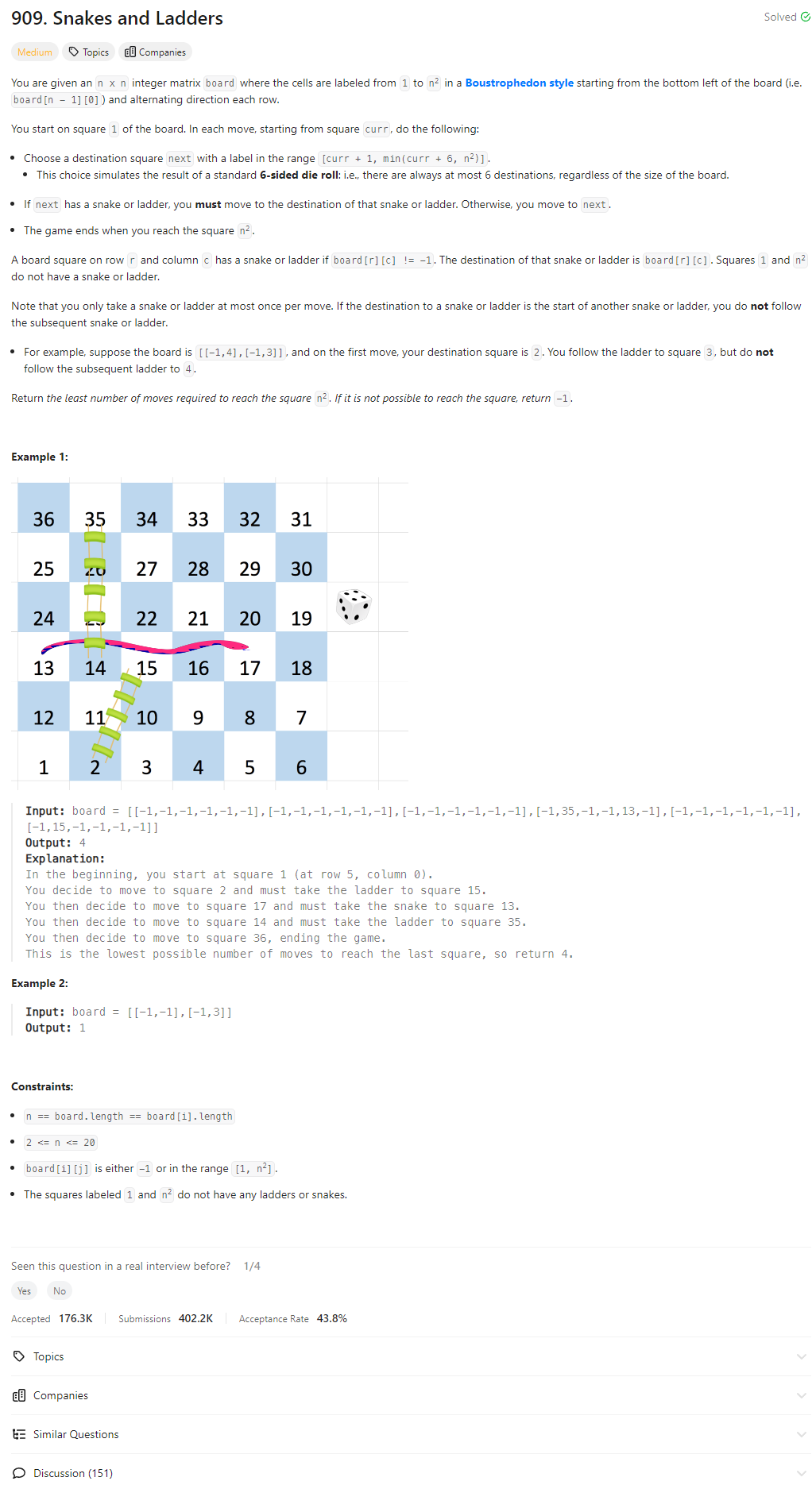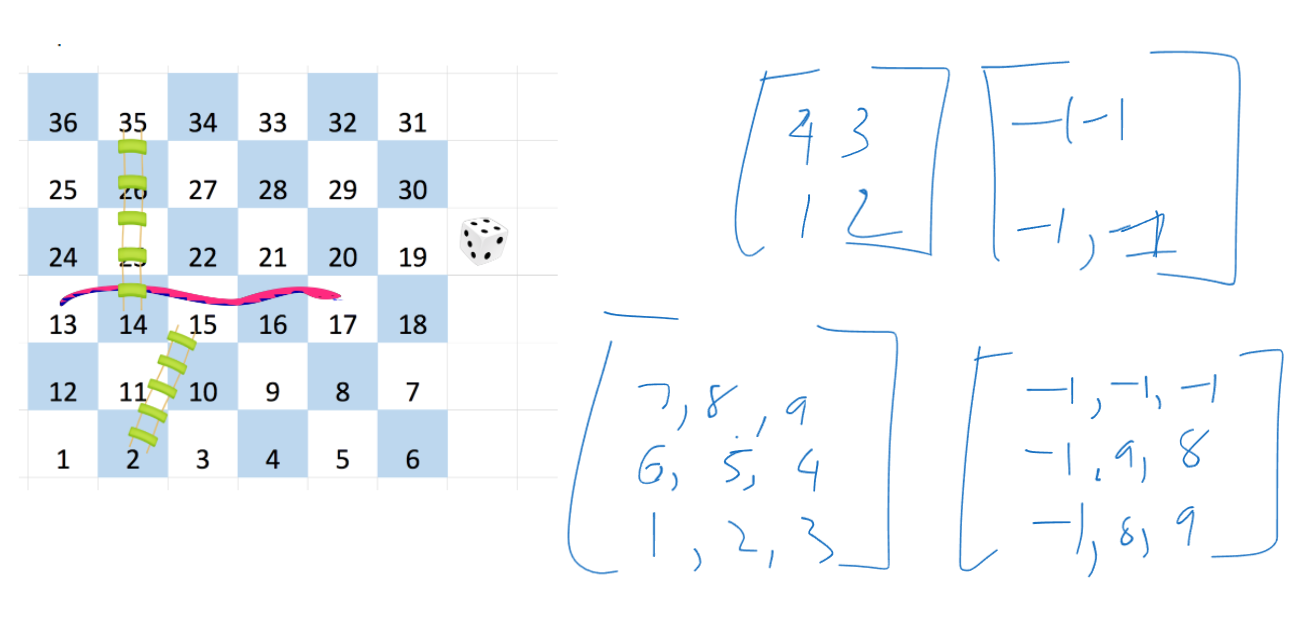Problem of The Day: Snakes and Ladders
Problem Statement

My notes:
- consider the following test cases

-
If encountering an off-by-one error, it’s crucial to reconsider the arrangement of the if-statements during checks or determine the final result when executing the BFS traversal.
Intuition
Upon reviewing the problem, I noticed that we need to traverse the board in a snake-like pattern, moving either left-to-right or right-to-left alternatively. My initial thought was to use a breadth-first search (BFS) approach to explore possible moves on the board.
Approach
I devised an approach where I first created a mapping from the numbers on the board to their corresponding row and column indices. Then, I used BFS to traverse the board, keeping track of the current position and the number of moves made. I continued exploring possible moves until I either reached the end of the board or exhausted all possible moves.
Complexity
-
Time complexity: O(N^2), where N is the size of the board, as we may potentially visit each cell of the board once.
-
Space complexity: O(N^2) as we use a hash map to store the mappings from numbers to their corresponding cell indices, and we also use a queue to perform BFS.
Code
from collections import defaultdict, deque
from typing import List
class Solution:
def snakesAndLadders(self, board: List[List[int]]) -> int:
N = len(board)
# Function to map numbers to their corresponding cell indices
def num_to_cell():
hash_map = defaultdict()
left_to_right = True
number = 1
for i in range(N - 1, -1, -1):
if left_to_right:
for j in range(N):
hash_map[number] = (i, j)
number += 1
else:
for j in range(N - 1, -1, -1):
hash_map[number] = (i, j)
number += 1
left_to_right = not left_to_right
return hash_map
num_to_cell_map = num_to_cell()
queue = deque()
queue.append([1, 0]) # Start with cell 1 and 0 moves
visited = set() # Set to keep track of visited cells
while queue:
curr, moves = queue.popleft()
# Explore possible moves from the current cell
for next_num in range(curr + 1, min(curr + 6, N * N) + 1):
r, c = num_to_cell_map[next_num]
next_node = board[r][c] if board[r][c] != -1 else next_num
# If we reach the end of the board, return the number of moves
if next_node == N * N:
return moves + 1
# If the next cell hasn't been visited, add it to the queue
if next_node not in visited:
visited.add(next_node)
queue.append([next_node, moves + 1])
# If we couldn't reach the end of the board, return -1
return -1
Editorial Solution
Approach 1: Breadth-first search
from collections import deque
class Solution:
def snakesAndLadders(self, board: List[List[int]]) -> int:
n = len(board)
cells = [None] * (n**2 + 1)
label = 1
columns = list(range(0, n))
for row in range(n - 1, -1, -1):
for column in columns:
cells[label] = (row, column)
label += 1
columns.reverse()
dist = [-1] * (n * n + 1)
q = deque([1])
dist[1] = 0
while q:
curr = q.popleft()
for next in range(curr + 1, min(curr + 6, n**2) + 1):
row, column = cells[next]
destination = (board[row][column] if board[row][column] != -1
else next)
if dist[destination] == -1:
dist[destination] = dist[curr] + 1
q.append(destination)
return dist[n * n]
Notes:
- In the above implementation,
distis an array representing the minimum number of moves required to reach each cell from the starting cell (cell 1). Settingdist[1]to 0 indicates that the starting cell itself is at distance 0. During BFS traversal, unvisited cells havedistset to -1. When visiting a cell, itsdistvalue is updated todist[curr] + 1, indicating the minimum number of moves to reach it from the current cell. This initialization ensures accurate distance calculation during BFS.
Interesting implementation
This is from Leetcode submission.
class Solution:
def snakesAndLadders(self, board: List[List[int]]) -> int:
length = len(board)
board.reverse()
def intToPos(square):
r = (square - 1) // length
c = (square - 1) % length
if r % 2:
c = length - 1 - c
return [r,c]
q = deque()
q.append([1,0]) # [squares,moves]
visit = set()
while q:
squares,moves = q.popleft()
for i in range(1,7):
nextSquare = squares + i
r,c = intToPos(nextSquare)
if board[r][c] != -1:
nextSquare = board[r][c]
if nextSquare == length*length:
return moves + 1
if nextSquare not in visit:
q.append([nextSquare,moves+1])
visit.add(nextSquare)
return -1